Tomato sauce is a staple ingredient in many recipes. But when you’re halfway through making a dish and realize this ingredient is missing, it’s time to use a substitute for tomato sauce to save your meal.
While nothing can completely replicate the taste of tomato sauce, some ingredients come pretty close. That’s precisely what we will be discussing in this article: the best alternatives to tomato sauce.
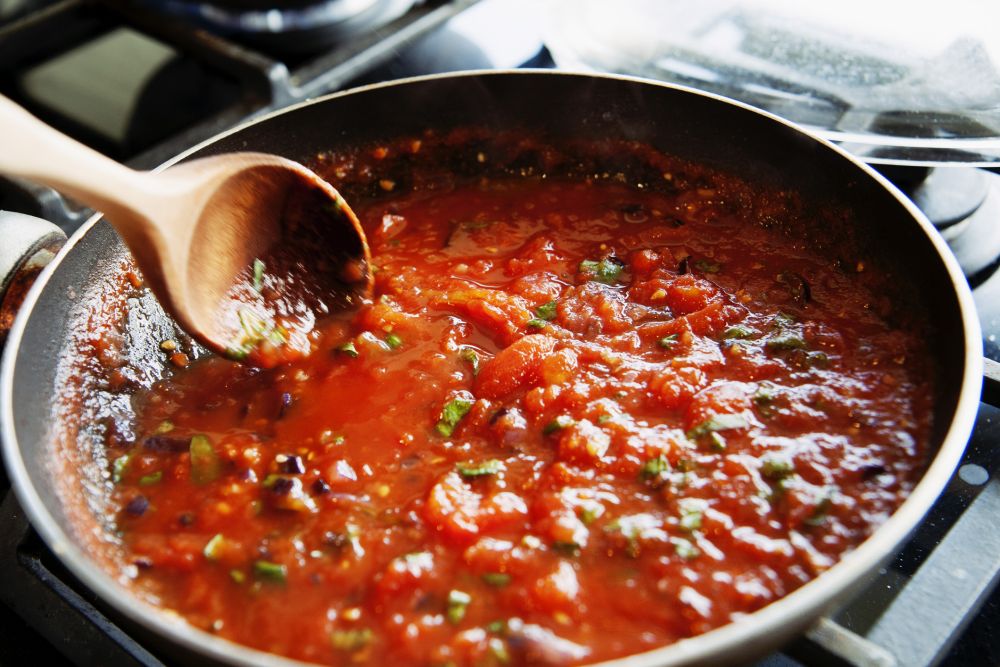
Tomato sauce is a thin sauce with a runny consistency, thicker than tomato juice but thinner than tomato purée. The sauce is base ingredient for other sauces, soups, meat, and vegetable stews, adding flavor, sharpness, moisture, and color. For example, tomato sauce is a common ingredient in Italian pasta recipes. A tomato sauce substitute should replicate at least part of these qualities.
Store-bought vs. homemade tomato sauce
There are two kinds of tomato sauce – store-bought and homemade – and there are noteable differences between them. Firstly, homemade tomato sauce is better since you have complete control over the ingredients used – the fresher the ingredients are, the more delicious the sauce will be. Secondly, store-bought tomato sauce is typically loaded with salt and sugar that act as natural preservatives, which could be problematic for people taking care of their salt and sugar intake. As such, homemade tomato sauce is the best substitute for store-bought tomato.
To prepare homemade tomato sauce and use it in place of store-bought tomato sauce, simmer chopped or puréed tomatoes for several hours until they lose their raw flavor, remove the tomato seeds, and strain the cooked tomatoes. How the sauce’s taste turns out largely depends on the quality of the vegetables used for simmering. For example, sweet tomatoes create a sweet sauce while sour tomatoes make a sour sauce unless the tartness is neutralized with sugar, baking soda, cinnamon, nutmeg, potatoes, carrots, or vegetable broth. Cooks typically add various ingredients to enhance the aroma of tomato sauce, such as salt, onions, garlic, wine, and herbs like oregano, bay leaf, and basil.
It’s not always possible to use homemade tomato sauce due to various reasons, like a lack of access to fresh tomatoes. So if the recipe calls for homemade tomato sauce, the best substitute is store-bought tomato sauce.
What’s the best substitute for tomato sauce?
Canned tomatoes, tomato paste, tomato purée, ketchup, tomato soup, marinara, beet-carrot paste, and ajvar are great alternative ingredients when you’re out of homemade or store-bought tomato sauce. Here’s a bit of useful information about each ingredient:
1. Canned tomatoes

Canned tomatoes are a great substitute for tomato sauce since they’re the next best thing to fresh tomatoes. Canned tomatoes are more concentrated than fresh tomatoes and less concentrated than tomato paste. Plus, canned tomatoes are densely packed and cook well. As such, you can use canned tomatoes in place of fresh tomatoes to quickly whip up a batch of tomato sauce.
You can buy canned tomatoes from any grocery store, whether you prefer them diced, stewed, or crushed for replacing tomato sauce.
To prepare tomato sauce from canned tomatoes, blend them until smooth, cook them to a simmer, and add seasoning. Canned tomatoes already have a bit of salt that acts as a natural preservative, so taste the resulting sauce before adding more salt.
When using canned tomatoes in place of tomato sauce, apply the 1:1 ratio. For example, use 1 cup of cooked and seasoned canned tomatoes to replace 1 cup of tomato sauce.
2. Tomato paste
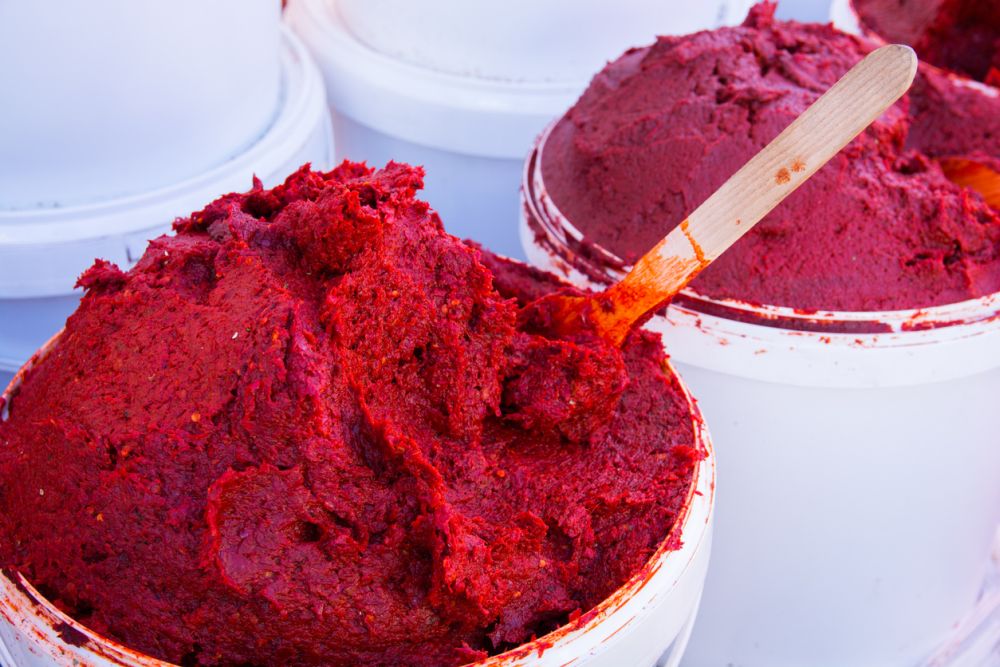
Tomato paste is one of the best tomato-based substitutes for tomato sauce. It goes both ways since you can also use tomato sauce as an alternative to tomato paste.
Compared to tomato sauce, tomato paste is more concentrated and has a thicker consistency. Cooks often use tomato paste to thicken sauces since it carries the rich, bold, and tart flavor of tomatoes with a hint of sweetness.
When using tomato paste to replace tomato sauce, there are two options: store-bought and homemade tomato paste. You can buy tomato paste in tubes or can, with the difference being that tubes are better since the paste won’t be exposed to air and will last longer. To prepare tomato paste at home, remove the seeds from tomatoes, slow-cook and strain the veggies, keep the resulting thick paste, and discard the liquid. Tomato paste lasts for 3-4 weeks in the fridge and for up to 9 months in the freezer.
When using tomato paste in place of tomato sauce, apply the 1:3 ratio. For example, add 1⁄3 cup of paste for every 1 cup of sauce. For a thinner consistency closer to the one of tomato sauce, mix 1⁄4 cup of tomato paste with 1⁄4 cup of water to replace 1 cup of tomato sauce. Season the tomato paste with your favorite herbs.
3. Tomato purée
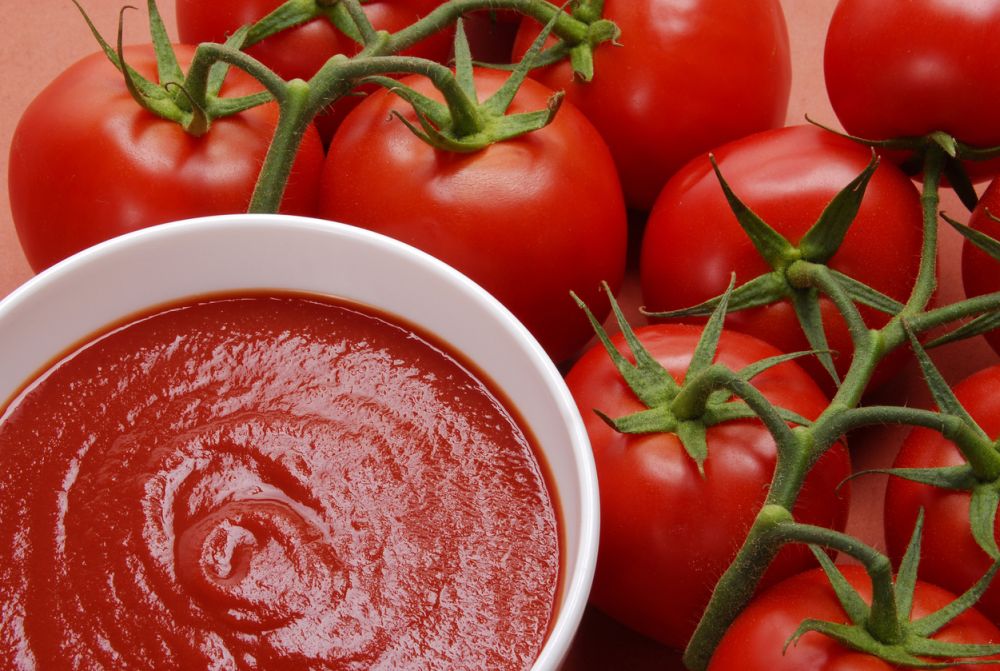
Tomato purée is a good substitute for tomato sauce in dishes that require a bit of acidity since the purée contains citric acid. As far as consistency is concerned, tomato purée is thicker than tomato sauce, thinner than tomato paste, and closer to blended canned tomatoes.
When using tomato purée to replace tomato sauce, there are two options: store-bought and homemade tomato purée. You can buy tomato purée in tubes or cans, with the key difference being that tubes are better since they aren’t exposed to air and last longer. To prepare tomato purée at home, cooking tomatoes, straining them to remove the seeds and skin, and blending the vegetables with a bit of salt and a citric acid like lemon juice or vinegar. Leave out the citric acid if you don’t like the tangy taste of homemade tomato purée. For store-bought tomato purée, add a splash of sugar, baking soda, cinnamon, nutmeg, potatoes, carrots, or vegetable broth during the cooking process to cancel the acid taste.
When using tomato purée in place of tomato sauce, apply the 1:1 ratio. For instance, use 1 cup of tomato purée for every 1 cup of tomato sauce. For a thinner consistency, mix 2⁄3 of tomato purée with 1⁄3 cup of water to replace 1 cup of tomato sauce.
4. Ketchup
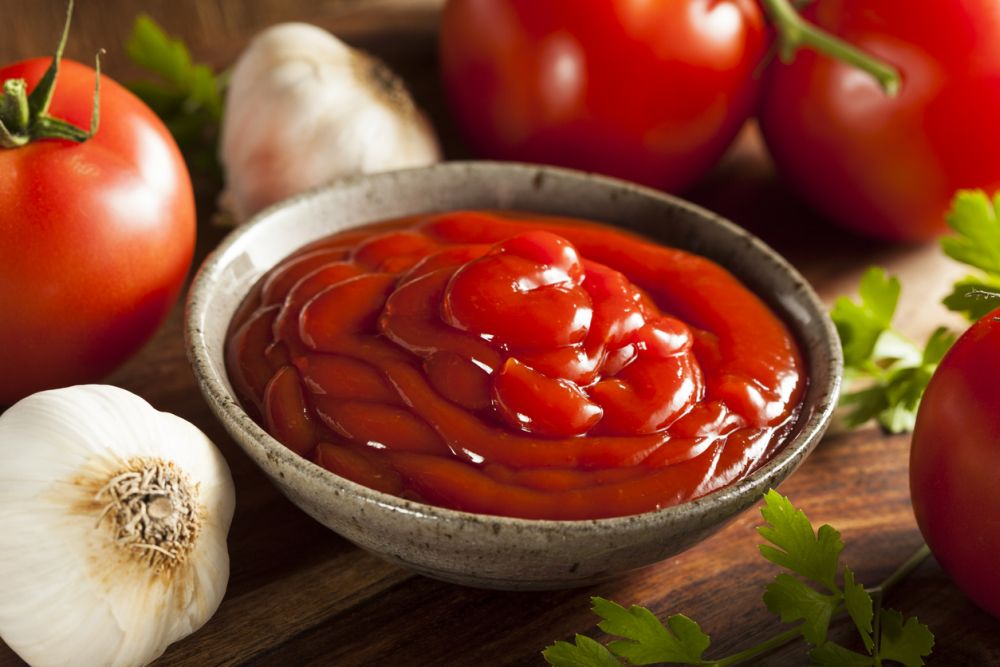
Ketchup is a decent substitute for tomato sauce since it has a consistency similar to tomato purée. Ketchup is made with tomatoes, sugar, acetic acid, and spices. But the amount of sugar is significantly high (1 teaspoon of sugar per 1 tablespoon of ketchup), and sugar comes from corn instead of tomatoes, which makes ketchup unhealthy.
When using ketchup in place of tomato sauce, apply the 1:1 ratio. For example, use 1 cup of ketchup for every 1 cup of tomato sauce. Cook the ketchup and mix it with herbs. To tone down the sweetness, add a bit of lemon juice or vinegar, taste, and add more if needed.
5. Tomato soup

Tomato soup is a pretty good substitute for tomato sauce, although it’s less flavorful and significantly thinner.
When using tomato soup to replace tomato sauce, there are two options – store-bought and homemade tomato soup -, with some notable differences. For example, store-bought tomato soup lasts longer (18-24 months) but is high in sodium, while homemade tomato soup gives you complete control over the ingredients used. With the proper storage conditions, homemade tomato soup lasts for 3-4 days in the refrigerator and for 3-6 months in the freezer.
When using tomato soup in place of tomato sauce, apply the 1:1 ratio. For example, add 1 cup of tomato soup for every 1 cup of tomato sauce and season as necessary. To make tomato soup thicker, mix it with a thickening agent, such as 1-2 tablespoons of cornstarch or tapioca.
6. Marinara

Marinara is a good alternative to tomato sauce, although the two differ in texture, ingredients used, and cooking time. While tomato sauce is smooth and runny, may include a wide range of ingredients, and takes several hours to cook, marinara is runny and contains chunks of tomatoes, uses red pepper, garlic and basil, and takes less than an hour to finish.
The flavor of marinara isn’t as powerful as the one of tomato sauce, making it ideal for rreplacing tomato sauce in pizza, pasta, and meatballs.
When using marinara to replace tomato sauce, there are two options – store-bought and homemade marinara. The key difference between the two is that store-bought marinara contains high amounts of sodium, so homemade marinara is healthier since you can add little salt as you want.
When using marinara in place of tomato sauce, apply the 1:1 ratio. For instance, add 1 cup of marinara for every 1 cup of tomato sauce. Enhance the marinara flavor by seasoning it with more herbs, and blend the marinara before adding it to your dish if you don’t like its chunky texture.
7. Beet-carrot paste
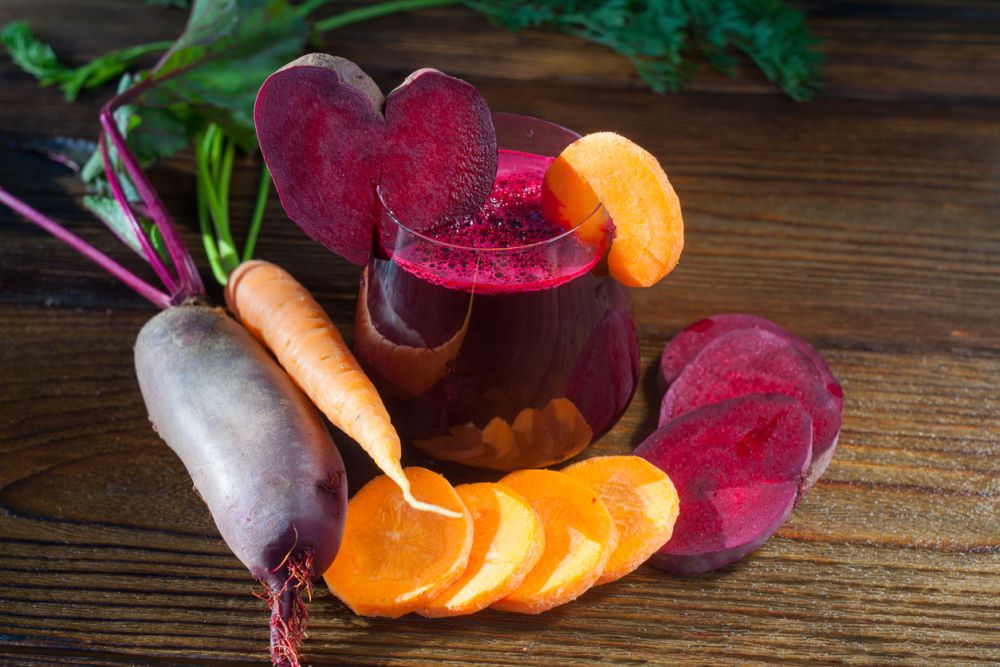
A beet-carrot paste is an excellent substitute for tomato sauce if you prefer an option that doesn’t include tomatoes (nomato sauce). Both beets and carrots have a sweet, earthy flavor that works well in most dishes, while the dark red of the beets makes up for the color of tomato sauce.
To prepare a paste from beets and carrots and use it to replace tomato sauce, simmer the two vegetables with garlic, olive oil, and your favorite herbs for several hours, and blend everything to form a paste. Cook the beet-carrot paste a few minutes longer with a thickening agent like tapioca or cornstarch if it’s too thin for your dish.
When using the beet-carrot paste in place of tomato sauce, apply the 1:1 ratio. For example, use 1 cup of this paste to replace 1 cup of tomato sauce.
8. Ajvar

Ajvar is a great no-tomato substitute for tomato sauce, thanks to its sweet, tangy, smoky aroma. This condiment is made from roasted red peppers and eggplant, and it’s traditional in Serbia and popular across the Balkan region. However, ajvar has a thicker consistency than tomato sauce.
When using ajvar to replace tomato sauce, there are two options – store-bought and homemade ajvar. The difference store-bought ajvar is typically pungent, and it’s rare to find sweet ajvar. So if you don’t like the spiciness of store-bought ajvar, make your own ajvar at home using grilled red peppers and eggplant, garlic, vegetable oil, white vinegar, salt, and pepper.
When using ajvar in place of tomato sauce, apply the 1:2 ratio. For example, use 1⁄2 cup of ajvar to replace 1 cup of tomato sauce. For a thinner consistency, mix 1⁄2 cup of Ajvar with 1⁄2 cup of water or vegetable broth to replace 1 cup of tomato sauce.
FAQs
Find out more information about tomato sauce.
How do you thicken up tomato sauce?
There are several ways to thicken tomato sauce. For instance, you can it simmer longer over low heat to reduce the liquid contents. Otherwise, you can mix the sauce with a tomato paste or a thickening agent like cornstarch or tapioca.
Can dogs eat tomato sauce?
No, dogs shouldn’t each tomato sauce because it may contain harmful ingredients for dogs, such as onions or garlic.
How long does tomato sauce last in the fridge?
Tomato sauce lasts for 3-5 days in the fridge once it has already been used, whether it’s store-bought or homemade.
Closing thoughts
There are many tomato sauce substitutes that you can use, depending on what you have in your pantry and what you are looking to make. For example, if you need a quick and easy ingredient for pizza or pasta, marinara works best. However, if you want something a little more flavorful, canned tomatoes are perfect for the job. No matter what type of tomato sauce substitute you use, be sure to adjust the seasonings in your recipe to account for the difference in flavor. With these tips in mind, you should be able to find the perfect replacement for tomato sauce in any dish.
The post The Best Substitute for Tomato Sauce: 8 Great Alternatives (Tomato-Free Included) appeared first on DIYs.com.






